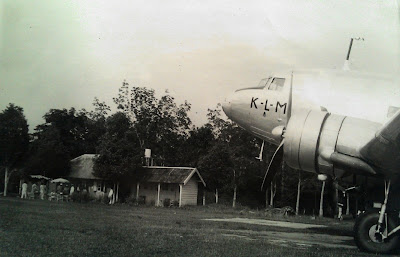The first two shots give an impression of what travel was like in the thirties. At the time KLM operated a scheduled service to Batavia, currently known as Jakarta, Indonesia. There was an intermediate stop in Palembang on the southern part of Sumatra. Looking at the first picture the airstrip was located right in the middle of the jungle. Based on the fact that the aircraft does not show a name below the cockpit, I presume this is a DC2 and not a DC3. If that is correct, the picture can be dated around 1935.
 |
| Palembang airport around 1935 with the "terminal" in the background. |
 |
| Captain Scholte entertaining his passengers? |
 |
| A hangar at the airport of Sydney. It probably doesn't exist anymore. |
As is demonstrated by the picture below, also after WW2 it was apparently necessary to clearly show ones identification.
Fuel consumption is one of the main cost factors for the airlines today. This in spite of the fact that fuel efficiency has greatly improved over the past decades. The Douglas DC7C, capable of carrying approx. 100 passengers, was able to tank some 34,800 liters. But looking at its empty weight (33,000 kgs) and its maximum take off weight (almost 65,000 kgs), filling the tanks to the brim hardly left any capacity for passengers... But then, I may be wrong here. But right or wrong, it is a very illustrative picture.
 |
| Douglas DC7C, PH-DSL 'Baltic Sea'. The picture is said to show 174 barrels of 200 liters each totalling 34,000 liters. Picture made between 8 Apr.1957 and Oct. 13, 1964. |



It really looks like a DC3 that one in Palembang. I have been comparing pics on google images and the DC2 is a bit more squarish and the wheel suspension looks different too. DC2 has got the words Uiver on the nose, or perhaps not on all of them.
ReplyDeleteThe both stand on their one hindwheel, hard to see. These are wonderful aircraft and I can even remember flying in a DC4, fantastic.
When in Darwin I happened to see a Conny fly over on a historic flight. I couldn't believe my eyes. In 1952 I flew in one. They were almost indestructable. Most pilots loved them, they were steady ships in the air.
You may be right!
ReplyDeleteThere was just one DC2 with the name "Uiver", that was the PH-AJU.
Thanks for your comments.
The photograph of PH-ASM looks like it has been retouched. Especially the letters "SM" look funny.
ReplyDeleteOtherwise great shots.
@Rob
ReplyDeleteI can vouch for the fact that neither this picture, nor any other one in this series, has been tampered with. However, I agree with you that some of these letters look kind of amateurish. But you have to appreciate the fact that this lettering has been applied some time during the thirties when not everything was as professional as it is today. Maybe it was a case of bad planning and the (self made?) M was a bit too large for the available space.
In any case, thanks for commenting.
The large markings HOLLAND were applied when World War Two broke out....Holland was a neutral country so KLM continued operating where they could... they were not permitted to cross French Airspace and were only allowed to land at Shoreham on England's South Coast. Rob can probably correct me, but I think it was after a KLM Douglas was shot up by the Luftwaffe on a Scaninavian service KLM painted their DC-2s and DC-3s orange with the large HOLLAND signs. In the spring of 1940 they even launched a non-stop over-water Amsterdam-Portugal DC-3 flight to link up with the new Pan Am Clipper flying boat service from New York but only managed a few flights before Holland was invaded.
ReplyDelete@Mick
ReplyDeleteThanks for your comment, much appreciated, I wasn't aware of these facts.
34 800 litres of gasoline equals to approx 25 000 kg so there was still quite good payload to be carried on the DC-7C.
ReplyDeleteSo that leaves a payload of approx. 7,000 kgs. That may have been enough to carry 100 pax and their luggage but just barely! In any case there was no payload left for my beloved cargo :-)
DeletePretty much all aircraft are payload/range restricted to a certain degree. So it's only a matter of finding the right route for the aircraft. If you don't use max range the you can carry more cargo ;)
ReplyDeleteYour starting point was 25 tons of fuel. That leaves a payload of 7 tons which is ok to fly a full pax load but no more. Obviously a lesser load of fuel means more payload.
Delete